从头编写 asp.net core 2.0 web api 基础框架 (5) EF CRUD
第1部分:http://www.cnblogs.com/cgzl/p/7637250.html
第2部分:http://www.cnblogs.com/cgzl/p/7640077.html
第3部分:http://www.cnblogs.com/cgzl/p/7652413.html
第4部分:http://www.cnblogs.com/cgzl/p/7661805.html
Github源码地址:https://github.com/solenovex/Building-asp.net-core-2-web-api-starter-template-from-scratch
这是第一大部分的最后一小部分。要完成CRUD的操作。
Repository Pattern
我们可以直接在Controller访问DbContext,但是可能会有一些问题:
1.相关的一些代码到处重复,有可能在程序中很多地方我都会更新Product,那样的话我可能就会在多个Action里面写同样的代码,而比较好的做法是只在一个地方写更新Product的代码。
2.到处写重复代码还会导致另外一个问题,那就是容易出错。
3.还有就是难以测试,如果想对Controller的Action进行单元测试,但是这些Action还包含着持久化相关的逻辑,这就很难的精确的找出到底是逻辑出错还是持久化部分出错了。
所以如果能有一种方法可以mock持久化相关的代码,然后再测试,就会知道错误不是发生在持久化部分了,这就可以用Repository Pattern了。
Repository Pattern是一种抽象,它减少了复杂性,目标是使代码对repository的实现更安全,并且与持久化要无关。
其中持久化无关这点我要明确一下,有时候是指可以随意切换持久化的技术,但这实际上并不是repository pattern的目的,其真正的目的是可以为repository挑选一个最好的持久化技术。例如:创建一个Product最好的方式可能是使用entity framework,而查询product最好的方式可能是使用dapper,也有可能会调用外部服务,而对调用repository的消费者来说,它不关心这些具体的实现细节。
首先再建立一个Material entity,然后和Product做成多对一的关系:
namespace CoreBackend.Api.Entities
{public class Material{public int Id { get; set; }public int ProductId { get; set; }public string Name { get; set; }public Product Product { get; set; }}public class MaterialConfiguration : IEntityTypeConfiguration<Material>{public void Configure(EntityTypeBuilder<Material> builder){builder.HasKey(x => x.Id);builder.Property(x => x.Name).IsRequired().HasMaxLength(50);builder.HasOne(x => x.Product).WithMany(x => x.Materials).HasForeignKey(x => x.ProductId).OnDelete(DeleteBehavior.Cascade);}}
}修改Product.cs:
namespace CoreBackend.Api.Entities
{public class Product{public int Id { get; set; }public string Name { get; set; }public float Price { get; set; }public string Description { get; set; }public ICollection<Material> Materials { get; set; }}public class ProductConfiguration : IEntityTypeConfiguration<Product>{public void Configure(EntityTypeBuilder<Product> builder){builder.HasKey(x => x.Id);builder.Property(x => x.Name).IsRequired().HasMaxLength(50);builder.Property(x => x.Price).HasColumnType("decimal(8,2)");builder.Property(x => x.Description).HasMaxLength(200);}}
}然后别忘了在Context里面注册Material的Configuration并添加DbSet属性:
namespace CoreBackend.Api.Entities
{public class MyContext : DbContext{public MyContext(DbContextOptions<MyContext> options): base(options){Database.Migrate();}public DbSet<Product> Products { get; set; }public DbSet<Material> Materials { get; set; }protected override void OnModelCreating(ModelBuilder modelBuilder){modelBuilder.ApplyConfiguration(new ProductConfiguration());modelBuilder.ApplyConfiguration(new MaterialConfiguration());}}
}然后添加一个迁移 Add-Migration AddMaterial:

然后数据库直接进行迁移操作了,无需再做update-database。
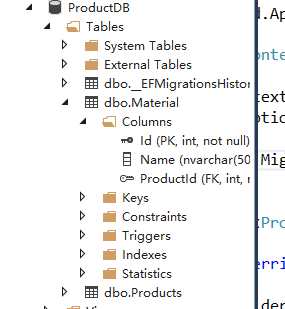
建立一个Repositories文件夹,添加一个IProductRepository:
namespace CoreBackend.Api.Repositories
{public interface IProductRepository{IEnumerable<Product> GetProducts();Product GetProduct(int productId, bool includeMaterials);IEnumerable<Material> GetMaterialsForProduct(int productId);Material GetMaterialForProduct(int productId, int materialId);}
}这个是ProductRepository将要实现的接口,里面定义了一些必要的方法:查询Products,查询单个Product,查询Product的Materials和查询Product下的一个Material。
其中类似GetProducts()这样的方法返回类型还是有争议的,IQueryable<T>还是IEnumerable<T>。
如果返回的是IQueryable,那么调用repository的地方还可以继续构建IQueryable,例如在真正的查询执行之前附加一个OrderBy或者Where方法。但是这样做的话,也意味着你把持久化相关的代码给泄露出去了,这看起来是违反了repository pattern的目的。
如果是IEnumerable,为了返回各种各样情况的查询结果,需要编写几十个上百个查询方法,那也是相当繁琐的,几乎是不可能的。
目前看来,两种返回方式都有人在用,所以根据情况定吧。我们的程序需求比较简单,所以使用IEnumerable。
然后建立具体的实现类 ProductRepository:
namespace CoreBackend.Api.Repositories
{public class ProductRepository : IProductRepository{private readonly MyContext _myContext;public ProductRepository(MyContext myContext){_myContext = myContext;}public IEnumerable<Product> GetProducts(){return _myContext.Products.OrderBy(x => x.Name).ToList();}public Product GetProduct(int productId, bool includeMaterials){if (includeMaterials){return _myContext.Products.Include(x => x.Materials).FirstOrDefault(x => x.Id == productId);}return _myContext.Products.Find(productId);}public IEnumerable<Material> GetMaterialsForProduct(int productId){return _myContext.Materials.Where(x => x.ProductId == productId).ToList();}public Material GetMaterialForProduct(int productId, int materialId){return _myContext.Materials.FirstOrDefault(x => x.ProductId == productId && x.Id == materialId);}}
}这里面要包含吃就会的逻辑,所以我们需要MyContext(也有可能需要其他的Service)那就在Constructor里面注入一个。重要的是调用的程序不关心这些细节。
这里也是编写额外的持久化逻辑的地方,比如说查询之后做个排序之类的。
(具体的Entity Framework Core的方法请查阅EF Core官方文档:https://docs.microsoft.com/en-us/ef/core/)
GetProducts,查询所有的产品并按照名称排序并返回查询结果。这里注意一定要加上ToList(),它保证了对数据库的查询就在此时此刻发生。
GetProduct,查询单个产品,判断一下是否需要把产品下面的原料都一起查询出来,如果需要的话就使用Include这个extension method。查询条件可以放在FirstOrDefault()方法里面。
GetMaterialsForProduct,查询某个产品下所有的原料。
GetMaterialForProduct,查询某个产品下的某种原料。
建立好Repository之后,需要在Startup里面进行注册:
public void ConfigureServices(IServiceCollection services){services.AddMvc();
#if DEBUGservices.AddTransient<IMailService, LocalMailService>();
#elseservices.AddTransient<IMailService, CloudMailService>();
#endifvar connectionString = Configuration["connectionStrings:productionInfoDbConnectionString"];services.AddDbContext<MyContext>(o => o.UseSqlServer(connectionString));services.AddScoped<IProductRepository, ProductRepository>();}针对Repository,最好的生命周期是Scoped(每个请求生成一个实例)。<>里面前边是它的合约接口,后边是具体实现。
使用Repository
先为ProductDto添加一个属性:
namespace CoreBackend.Api.Dtos
{public class ProductDto{public ProductDto(){Materials = new List<MaterialDto>();}public int Id { get; set; }public string Name { get; set; }public float Price { get; set; }public string Description { get; set; }public ICollection<MaterialDto> Materials { get; set; }public int MaterialCount => Materials.Count;}
}就是返回该产品所用的原料个数。
再建立一个ProductWithoutMaterialDto:
namespace CoreBackend.Api.Dtos
{public class ProductWithoutMaterialDto{public int Id { get; set; }public string Name { get; set; }public float Price { get; set; }public string Description { get; set; }}
}这个Dto不带原料相关的导航属性。
然后修改controller。
现在我们可以使用ProductRepository替代原来的内存数据了,首先在ProductController里面注入ProductRepository:
public class ProductController : Controller{private readonly ILogger<ProductController> _logger;private readonly IMailService _mailService;private readonly IProductRepository _productRepository;public ProductController(ILogger<ProductController> logger,IMailService mailService, IProductRepository productRepository){_logger = logger;_mailService = mailService;_productRepository = productRepository;}1.修改GetProducts这个Action:
[HttpGet]public IActionResult GetProducts(){var products = _productRepository.GetProducts();var results = new List<ProductWithoutMaterialDto>();foreach (var product in products){results.Add(new ProductWithoutMaterialDto{Id = product.Id,Name = product.Name,Price = product.Price,Description = product.Description});}return Ok(results);}注意,其中的Product类型是DbContext和repository操作的类型,而不是Action应该返回的类型,而且我们的查询结果是不带Material的,所以需要把Product的list映射成ProductWithoutMaterialDto的list。
然后试试:
查询的时候报错,是因为Product的属性Price,在fluentapi里面设置的类型是decimal(8, 2),而Price的类型是float,那么我们把所有的Price的类型都改成decimal:
public class Product{public int Id { get; set; }public string Name { get; set; }public decimal Price { get; set; }public string Description { get; set; }public ICollection<Material> Materials { get; set; }}public class ProductCreation{[Display(Name = "产品名称")][Required(ErrorMessage = "{0}是必填项")][StringLength(10, MinimumLength = 2, ErrorMessage = "{0}的长度应该不小于{2}, 不大于{1}")]public string Name { get; set; }[Display(Name = "价格")][Range(0, Double.MaxValue, ErrorMessage = "{0}的值必须大于{1}")]public decimal Price { get; set; }[Display(Name = "描述")][MaxLength(100, ErrorMessage = "{0}的长度不可以超过{1}")]public string Description { get; set; }}public class ProductDto{public ProductDto(){Materials = new List<MaterialDto>();}public int Id { get; set; }public string Name { get; set; }public decimal Price { get; set; }public string Description { get; set; }public ICollection<MaterialDto> Materials { get; set; }public int MaterialCount => Materials.Count;}public class ProductModification{[Display(Name = "产品名称")][Required(ErrorMessage = "{0}是必填项")][StringLength(10, MinimumLength = 2, ErrorMessage = "{0}的长度应该不小于{2}, 不大于{1}")]public string Name { get; set; }[Display(Name = "价格")][Range(0, Double.MaxValue, ErrorMessage = "{0}的值必须大于{1}")]public decimal Price { get; set; }[Display(Name = "描述")][MaxLength(100, ErrorMessage = "{0}的长度不可以超过{1}")]public string Description { get; set; }}public class ProductWithoutMaterialDto{public int Id { get; set; }public string Name { get; set; }public decimal Price { get; set; }public string Description { get; set; }}还有SeedData里面和即将废弃的ProductService:


namespace CoreBackend.Api.Entities
{public static class MyContextExtensions{public static void EnsureSeedDataForContext(this MyContext context){if (context.Products.Any()){return;}var products = new List<Product>{new Product{Name = "牛奶",Price = new decimal(2.5),Description = "这是牛奶啊"},new Product{Name = "面包",Price = new decimal(4.5),Description = "这是面包啊"},new Product{Name = "啤酒",Price = new decimal(7.5),Description = "这是啤酒啊"}};context.Products.AddRange(products);context.SaveChanges();}}
}namespace CoreBackend.Api.Services
{public class ProductService{public static ProductService Current { get; } = new ProductService();public List<ProductDto> Products { get; }private ProductService(){Products = new List<ProductDto>{new ProductDto{Id = 1,Name = "牛奶",Price = new decimal(2.5),Materials = new List<MaterialDto>{new MaterialDto{Id = 1,Name = "水"},new MaterialDto{Id = 2,Name = "奶粉"}},Description = "这是牛奶啊"},new ProductDto{Id = 2,Name = "面包",Price = new decimal(4.5),Materials = new List<MaterialDto>{new MaterialDto{Id = 3,Name = "面粉"},new MaterialDto{Id = 4,Name = "糖"}},Description = "这是面包啊"},new ProductDto{Id = 3,Name = "啤酒",Price = new decimal(7.5),Materials = new List<MaterialDto>{new MaterialDto{Id = 5,Name = "麦芽"},new MaterialDto{Id = 6,Name = "地下水"}},Description = "这是啤酒啊"}};}}
}View Code
然后在运行试试:
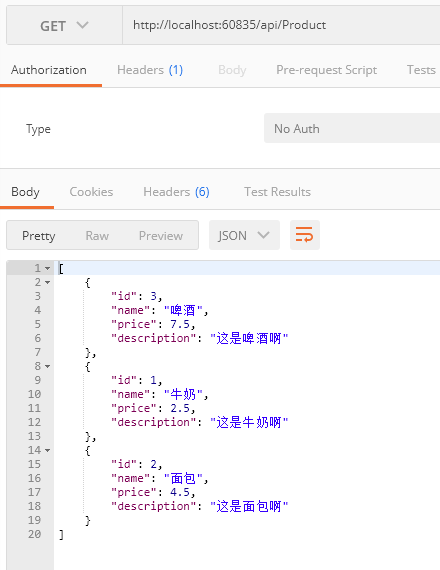
结果正确。
然后修改GetProduct:
[Route("{id}", Name = "GetProduct")]public IActionResult GetProduct(int id, bool includeMaterial = false){var product = _productRepository.GetProduct(id, includeMaterial);if (product == null){return NotFound();}if (includeMaterial){var productWithMaterialResult = new ProductDto{Id = product.Id,Name = product.Name,Price = product.Price,Description = product.Description};foreach (var material in product.Materials){productWithMaterialResult.Materials.Add(new MaterialDto{Id = material.Id,Name = material.Name});}return Ok(productWithMaterialResult);}var onlyProductResult = new ProductDto{Id = product.Id,Name = product.Name,Price = product.Price,Description = product.Description};return Ok(onlyProductResult);}首先再添加一个参数includeMaterial表示是否带着Material表的数据一起查询出来,该参数有一个默认值是false,就是请求的时候如果不带这个参数,那么这个参数的值就是false。
通过repository查询之后把Product和Material分别映射成ProductDto和MaterialDot。
试试,首先不包含Material:
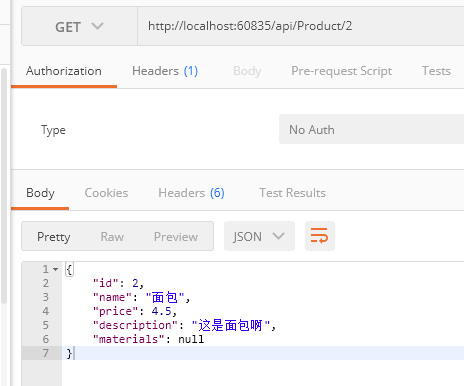
目前数据库的Material表没有数据,可以手动添加几个,也可以把数据库的Product数据删了,改一下种子数据那部分代码:


namespace CoreBackend.Api.Entities
{public static class MyContextExtensions{public static void EnsureSeedDataForContext(this MyContext context){if (context.Products.Any()){return;}var products = new List<Product>{new Product{Name = "牛奶",Price = new decimal(2.5),Description = "这是牛奶啊",Materials = new List<Material>{new Material{Name = "水"},new Material{Name = "奶粉"}}},new Product{Name = "面包",Price = new decimal(4.5),Description = "这是面包啊",Materials = new List<Material>{new Material{Name = "面粉"},new Material{Name = "糖"}}},new Product{Name = "啤酒",Price = new decimal(7.5),Description = "这是啤酒啊",Materials = new List<Material>{new Material{Name = "麦芽"},new Material{Name = "地下水"}}}};context.Products.AddRange(products);context.SaveChanges();}}
}View Code
然后再试试GetProduct带有material的查询:
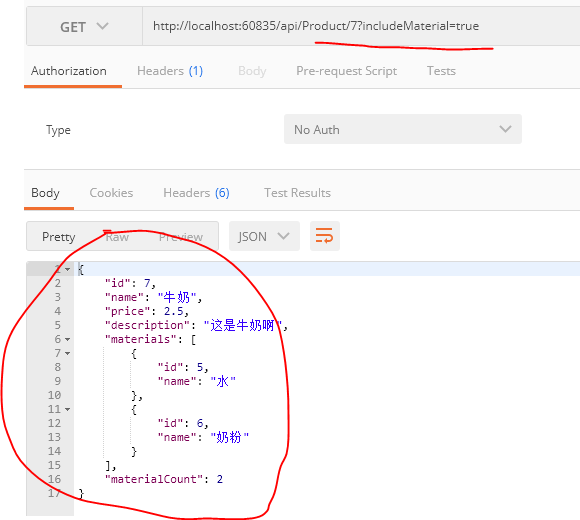
其中inludeMaterail这个参数需要使用query string的方式,也就是在uri后边加一个问号,问号后边跟着参数名,然后是等号,然后是它的值。如果有多个query string的参数,那么每组参数之间用&分开。
然后再修改一下MaterialController:
namespace CoreBackend.Api.Controllers
{[Route("api/product")] // 和主Model的Controller前缀一样public class MaterialController : Controller{private readonly IProductRepository _productRepository;public MaterialController(IProductRepository productRepository){_productRepository = productRepository;}[HttpGet("{productId}/materials")]public IActionResult GetMaterials(int productId){var materials = _productRepository.GetMaterialsForProduct(productId);var results = materials.Select(material => new MaterialDto{Id = material.Id,Name = material.Name}).ToList();return Ok(results);}[HttpGet("{productId}/materials/{id}")]public IActionResult GetMaterial(int productId, int id){var material = _productRepository.GetMaterialForProduct(productId, id);if (material == null){return NotFound();}var result = new MaterialDto{Id = material.Id,Name = material.Name};return Ok(result);}}
}注意GetMaterials方法内,我们往productRepository的GetMaterialsForProduct传进去一个productId,如果repository返回的是空list可能会有两种情况:1 product不存在,2 product存在,而它没有下属的material。如果是第一种情况,那么应该返回的是404 NotFound,而第二种action应该返回一个空list。所以我们需要一个方法判断product是否存在,所以打开ProductRepository,添加方法:
public bool ProductExist(int productId){return _myContext.Products.Any(x => x.Id == productId);}并在pull up member(右键点击方法代码--重构里面有)到接口里面:
namespace CoreBackend.Api.Repositories
{public interface IProductRepository{IEnumerable<Product> GetProducts();Product GetProduct(int productId, bool includeMaterials);IEnumerable<Material> GetMaterialsForProduct(int productId);Material GetMaterialForProduct(int productId, int materialId);bool ProductExist(int productId);}
}然后再改一下Controller:
namespace CoreBackend.Api.Controllers
{[Route("api/product")] // 和主Model的Controller前缀一样public class MaterialController : Controller{private readonly IProductRepository _productRepository;public MaterialController(IProductRepository productRepository){_productRepository = productRepository;}[HttpGet("{productId}/materials")]public IActionResult GetMaterials(int productId){var product = _productRepository.ProductExist(productId);if (!product){return NotFound();}var materials = _productRepository.GetMaterialsForProduct(productId);var results = materials.Select(material => new MaterialDto{Id = material.Id,Name = material.Name}).ToList();return Ok(results);}[HttpGet("{productId}/materials/{id}")]public IActionResult GetMaterial(int productId, int id){var product = _productRepository.ProductExist(productId);if (!product){return NotFound();}var material = _productRepository.GetMaterialForProduct(productId, id);if (material == null){return NotFound();}var result = new MaterialDto{Id = material.Id,Name = material.Name};return Ok(result);}}
}试试:
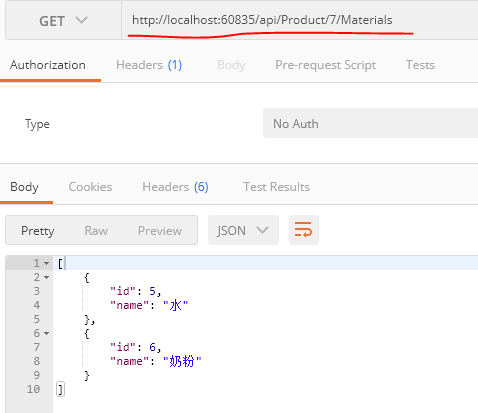
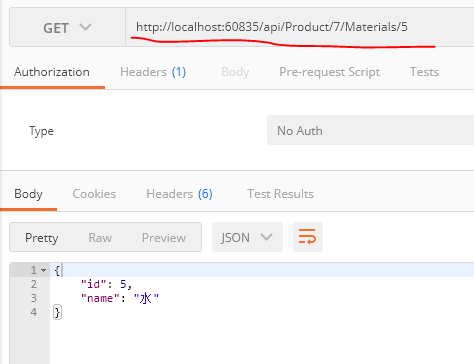
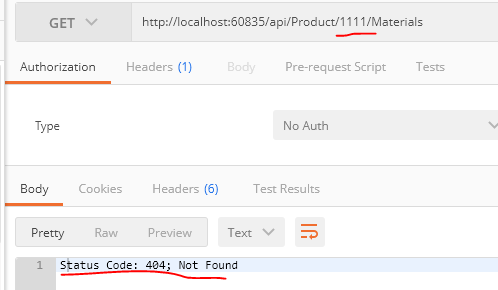
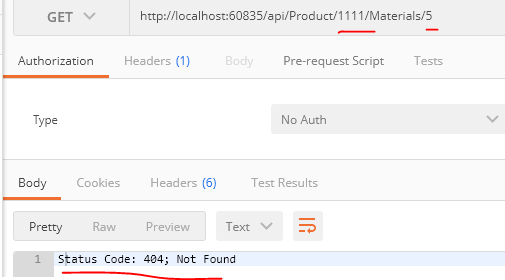
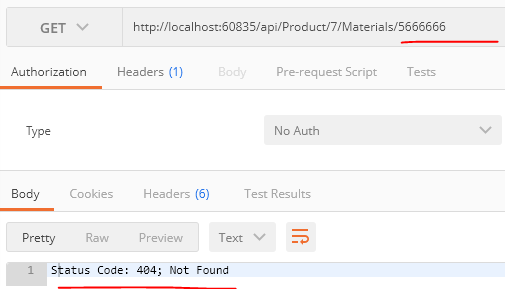
结果都没有问题!!!
但是看看上面controller里面的代码,到处都是映射,这种手写的映射很容易出错,如果entity有几十个属性,然后在多个地方需要进行映射,那么这么写实在太糟糕了。
所以需要使用一个映射的库:
AutoMapper
autoMapper是最主流的.net映射库,所以我们用它。
通过nuget安装automapper:
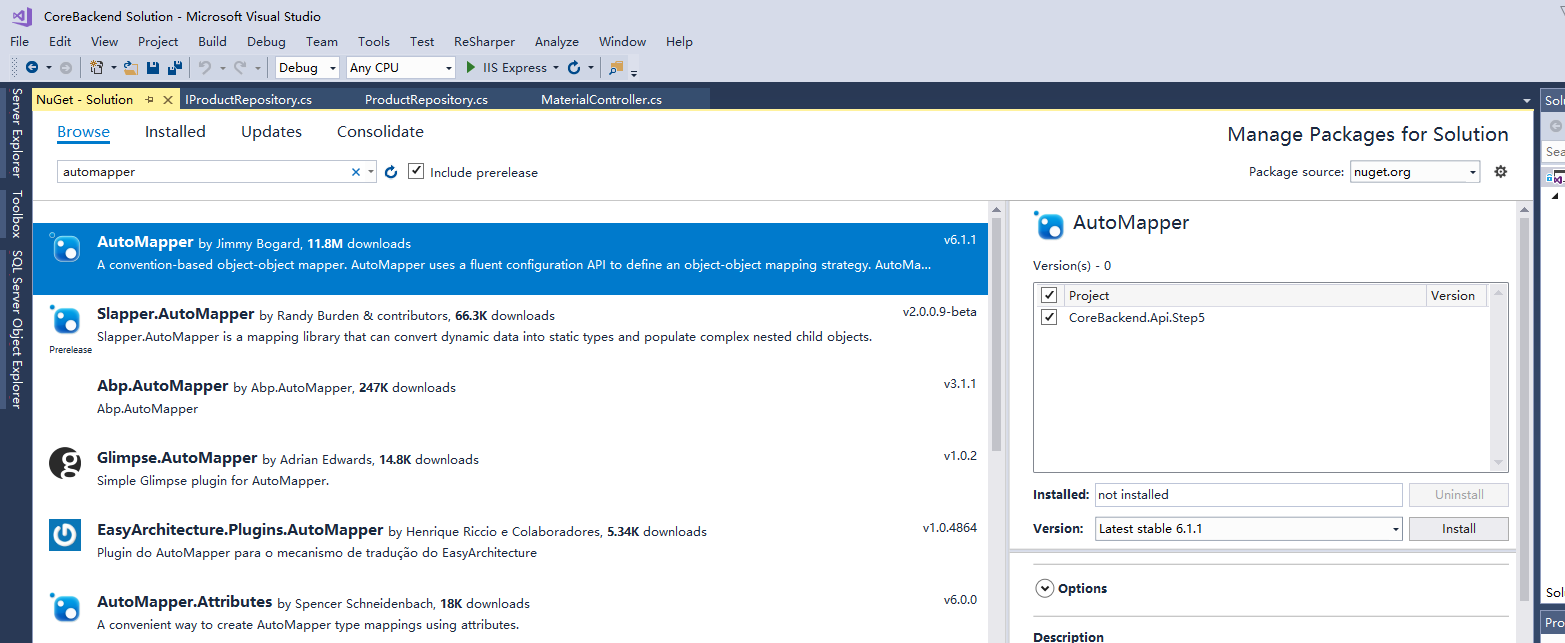
安装完之后,首先要配置automapper。我们要告诉automapper哪些entity和dto之间有映射关系。这个配置应该只创建一次,并且在startup的时候进行初始化。
在Startup的Configure方法添加:
public void Configure(IApplicationBuilder app, IHostingEnvironment env, ILoggerFactory loggerFactory,MyContext myContext){loggerFactory.AddNLog();if (env.IsDevelopment()){app.UseDeveloperExceptionPage();}else{app.UseExceptionHandler();}myContext.EnsureSeedDataForContext();app.UseStatusCodePages();AutoMapper.Mapper.Initialize(cfg =>{cfg.CreateMap<Product, ProductWithoutMaterialDto>();});
app.UseMvc();}创建映射关系,我们需要使用AutoMapper.Mapper.Initialize方法,其参数是一个Action,这个Action的参数是一个Mapping Configuration。
cfg.CreateMap<Product, ProductWithoutMaterialDto>(),意思就是创建一个从Product到ProductWIthoutMaterialDto的映射关系。
AutoMapper是基于约定的,原对象的属性值会被映射到目标对象相同属性名的属性上。如果属性不存在,那么就忽略它。
偶尔我们可能需要对AutoMapper的映射进行一些微调,但是对于大多数情况来说,上面这一句话就够用了。
现在可以在controller里面使用这个映射了。
打开controller首先改一下GetProducts:
[HttpGet]public IActionResult GetProducts(){var products = _productRepository.GetProducts();var results = Mapper.Map<IEnumerable<ProductWithoutMaterialDto>>(products);return Ok(results);}使用Mapper.Map进行映射,<T>其中T是目标类型,可以是一个model也可以是一个集合,括号里面的参数是原对象们。
运行试试:
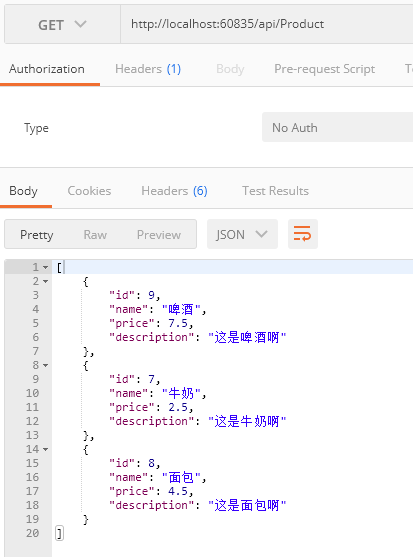
没问题,结果和之前是一样的。
然后针对GetProduct,首先再建立一对映射:
AutoMapper.Mapper.Initialize(cfg =>{cfg.CreateMap<Product, ProductWithoutMaterialDto>();cfg.CreateMap<Product, ProductDto>();});然后GetProduct:
[Route("{id}", Name = "GetProduct")]public IActionResult GetProduct(int id, bool includeMaterial = false){var product = _productRepository.GetProduct(id, includeMaterial);if (product == null){return NotFound();}if (includeMaterial){var productWithMaterialResult = Mapper.Map<ProductDto>(product);return Ok(productWithMaterialResult);}var onlyProductResult = Mapper.Map<ProductWithoutMaterialDto>(product);return Ok(onlyProductResult);}运行,查询包含Material,报错:

这是因为ProductDto里面有一个属性 ICollection<Material> Materials,automapper不知道应该怎么去映射它,所以我们需要再添加一对Material到MaterialDto的映射关系。
AutoMapper.Mapper.Initialize(cfg =>{cfg.CreateMap<Product, ProductWithoutMaterialDto>();cfg.CreateMap<Product, ProductDto>(); cfg.CreateMap<Material, MaterialDto>();});运行:
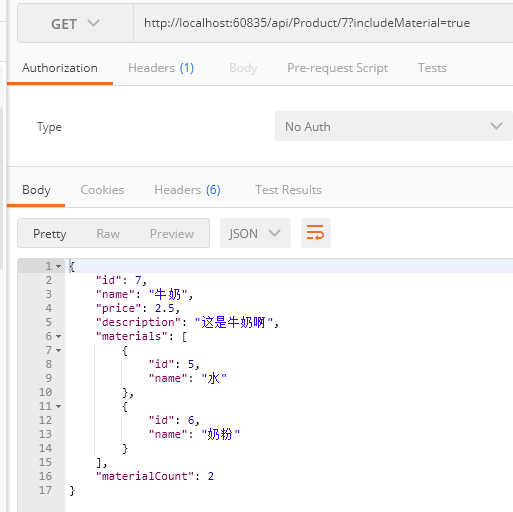
没问题。
然后把MaterailController里面也改一下:


namespace CoreBackend.Api.Controllers
{[Route("api/product")] // 和主Model的Controller前缀一样public class MaterialController : Controller{private readonly IProductRepository _productRepository;public MaterialController(IProductRepository productRepository){_productRepository = productRepository;}[HttpGet("{productId}/materials")]public IActionResult GetMaterials(int productId){var product = _productRepository.ProductExist(productId);if (!product){return NotFound();}var materials = _productRepository.GetMaterialsForProduct(productId);var results = Mapper.Map<IEnumerable<MaterialDto>>(materials);return Ok(results);}[HttpGet("{productId}/materials/{id}")]public IActionResult GetMaterial(int productId, int id){var product = _productRepository.ProductExist(productId);if (!product){return NotFound();}var material = _productRepository.GetMaterialForProduct(productId, id);if (material == null){return NotFound();}var result = Mapper.Map<MaterialDto>(material);return Ok(result);}}
}View Code
运行一下都应该没有什么问题。
上面都是查询的Actions。
下面开始做CUD的映射更改。
添加:
修改ProductRepository,添加以下方法:
public void AddProduct(Product product){_myContext.Products.Add(product);}public bool Save(){return _myContext.SaveChanges() >= 0;}AddProduct会把传进来的product添加到context的内存中(姑且这么说),但是还没有更新到数据库。
Save方法里面是把context所追踪的实体变化(CUD)更新到数据库。
然后把这两个方法提取到IProductRepository接口里:
public interface IProductRepository{IEnumerable<Product> GetProducts();Product GetProduct(int productId, bool includeMaterials);IEnumerable<Material> GetMaterialsForProduct(int productId);Material GetMaterialForProduct(int productId, int materialId);bool ProductExist(int productId);void AddProduct(Product product);bool Save();}修改Controller的Post:
[HttpPost]public IActionResult Post([FromBody] ProductCreation product){if (product == null){return BadRequest();}if (product.Name == "产品"){ModelState.AddModelError("Name", "产品的名称不可以是'产品'二字");}if (!ModelState.IsValid){return BadRequest(ModelState);}var newProduct = Mapper.Map<Product>(product);_productRepository.AddProduct(newProduct);if (!_productRepository.Save()){return StatusCode(500, "保存产品的时候出错");}var dto = Mapper.Map<ProductWithoutMaterialDto>(newProduct);return CreatedAtRoute("GetProduct", new { id = dto.Id }, dto);}注意别忘了要返回的是Dto。
运行:
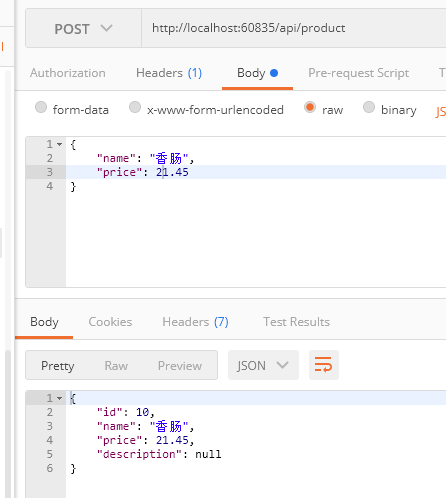
没问题。
Put
cfg.CreateMap<ProductModification, Product>();
[HttpPut("{id}")]public IActionResult Put(int id, [FromBody] ProductModification productModificationDto){if (productModificationDto == null){return BadRequest();}if (productModificationDto.Name == "产品"){ModelState.AddModelError("Name", "产品的名称不可以是'产品'二字");}if (!ModelState.IsValid){return BadRequest(ModelState);}var product = _productRepository.GetProduct(id);if (product == null){return NotFound();}Mapper.Map(productModificationDto, product);if (!_productRepository.Save()){return StatusCode(500, "保存产品的时候出错");}return NoContent();}这里我们使用了Mapper.Map的另一个overload的方法,它有两个参数。这个方法会把第一个对象相应的值赋给第二个对象上。这时候product的state就变成了modified了。
然后保存即可。
试试:
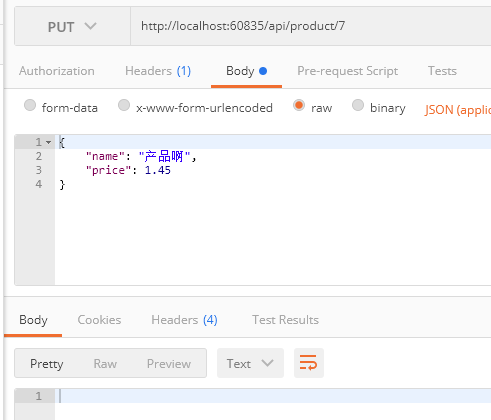
Partial Update
cfg.CreateMap<Product, ProductModification>();
[HttpPatch("{id}")]public IActionResult Patch(int id, [FromBody] JsonPatchDocument<ProductModification> patchDoc){if (patchDoc == null){return BadRequest();}var productEntity = _productRepository.GetProduct(id);if (productEntity == null){return NotFound();}var toPatch = Mapper.Map<ProductModification>(productEntity);patchDoc.ApplyTo(toPatch, ModelState);if (!ModelState.IsValid){return BadRequest(ModelState);}if (toPatch.Name == "产品"){ModelState.AddModelError("Name", "产品的名称不可以是'产品'二字");}TryValidateModel(toPatch);if (!ModelState.IsValid){return BadRequest(ModelState);}Mapper.Map(toPatch, productEntity);if (!_productRepository.Save()){return StatusCode(500, "更新的时候出错");}return NoContent();}试试:
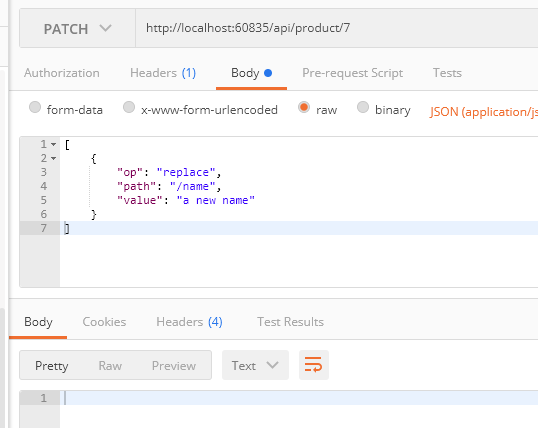
没问题。
Delete
只是替换成repository,不涉及mapping。
在Repository添加一个Delete方法:
public void DeleteProduct(Product product){_myContext.Products.Remove(product);}提取到IProductRepository:
void DeleteProduct(Product product);
然后Controller:
[HttpDelete("{id}")]public IActionResult Delete(int id){var model = _productRepository.GetProduct(id);if (model == null){return NotFound();}_productRepository.DeleteProduct(model);if (!_productRepository.Save()){return StatusCode(500, "删除的时候出错");}_mailService.Send("Product Deleted",$"Id为{id}的产品被删除了");return NoContent();}运行:

Ok。
第一大部分先写到这。。。。。。。。。。。。
接下来几天比较忙,然后我再编写第二大部分。我会直接弄一个已经重构好的模板,简单讲一下,然后重点是Identity Server 4.
到目前为止可以进行CRUD操作了,接下来需要把项目重构一下,然后再简单用一下Identity Server4。
下面是我的关于ASP.NET Core Web API相关技术的公众号--草根专栏:
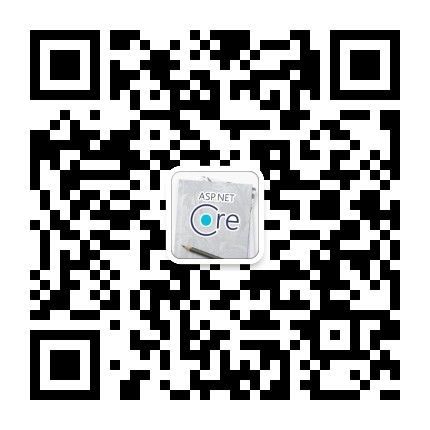
从头编写 asp.net core 2.0 web api 基础框架 (5) EF CRUD相关推荐
- 从头编写 asp.net core 2.0 web api 基础框架 (4) EF配置
第一部分: https://www.cnblogs.com/frank0812/p/11165940.html 第二部分:https://www.cnblogs.com/frank0812/p/111 ...
- 从头编写 asp.net core 2.0 web api 基础框架 (2)
上一篇是: 从头编写 asp.net core 2.0 web api 基础框架 (1) Github源码地址是: https://github.com/solenovex/Building-asp. ...
- 【转载】从头编写 asp.net core 2.0 web api 基础框架 (1)
工具: 1.Visual Studio 2017 V15.3.5+ 2.Postman (Chrome的App) 3.Chrome (最好是) 关于.net core或者.net core 2.0的相 ...
- 从头编写 asp.net core 2.0 web api 基础框架 (1)
工具: 1.Visual Studio 2017 V15.3.5+ 2.Postman (Chrome的App) 3.Chrome (最好是) 关于.net core或者.net core 2.0的相 ...
- asp.net core 2.0 web api + Identity Server 4 + angular 5 可运行前后台源码
前台使用angular 5, 后台是asp.net core 2.0 web api + identity server 4. 从头编写asp.net core 2.0 web api 基础框架: 第 ...
- ASP.NET Core 5.0 Web API 自动集成Swashbuckle
ASP.NET Core 5.0 Web API与开放源代码项目 Swashbuckle.AspNetCore 的维护人员合作,ASP.NET Core API 模板包含对 Swashbuckle 的 ...
- 用VSCode开发一个asp.net core2.0+angular5项目(5): Angular5+asp.net core 2.0 web api文件上传...
第一部分: http://www.cnblogs.com/cgzl/p/8478993.html 第二部分: http://www.cnblogs.com/cgzl/p/8481825.html 第三 ...
- ASP.NET Core 2.0 Web API项目升级到ASP.NET Core 3.0概要笔记
本文结构 先决条件 升级目标框架(Target Framework)的版本 过时的IHostingEnvironment与IApplicationLifetime对象 Endpoint Routing ...
- asp.net core 2.0 web api基于JWT自定义策略授权
JWT(json web token)是一种基于json的身份验证机制,流程如下: 通过登录,来获取Token,再在之后每次请求的Header中追加Authorization为Token的凭据,服务端 ...
最新文章
- 卡巴斯基7.0防病毒官方中文版
- 如何使用Visual Studio Code作为Git的默认编辑器
- 体感开发学习总结 - 二
- python 参数解析器_Python参数解析器,在h之前引发异常
- javax.websocket.DeploymentException: The path [webScoketServiceBaidu/{appID}] is not valid.
- traceroute程序_来!程序猿教你们玩微信代码~
- mysql数据库的备份和恢复的常用方法_MySQL数据库备份与恢复方法(转)
- 蚂蚁资深技术专家王旭:开源项目是如何让这个世界更安全的?
- 大数据面试求职经验总结
- jetson windows_生命不息,折腾不止:Jetson Nano填坑之软件篇
- 阶段5 3.微服务项目【学成在线】_day02 CMS前端开发_21-CMS前端页面查询开发-Api调用...
- bom sap 替代项目_SAP BOM替代物料讲解
- OpManager引领智能运维未来的发展方向
- 2寸的照片长宽各是多少_两寸照片多少厘米?2寸免冠照片尺寸是多少?2寸免冠照片长宽多少?...
- 使用rufus制作windows系统安装u盘
- 65.(cesium篇)cesium单个地图图片
- 大卫 异星觉醒 机器人_《异星觉醒》披着科幻外衣的老套惊悚片
- 表格下拉选项怎么添加,开启快速添加模式
- 4核处理器_【装机帮扶站】第489期:盘点一波100元以下的4核/6核/8核/10核/12核处理器(2)...
- 《Python神经网络编程》自己动手编写一个神经网络
热门文章
- c/c++标准预定义宏
- linux驱动:音频驱动(三)ASoc之machine驱动及card初始化
- mp4 android自动播放,Android 使用VideoView播放MP4的简单实现
- 董东 java_Java面向对象程序设计
- 分解例题及解析_【高考物理】考前梳理,高中物理经典常考例题(带解析),收藏起来考试不低于90+!...
- yii2 后台权限验证获取用户身份_Yii2搭建后台并实现rbac权限控制完整实例教程...
- 英语计算机工程师求职信,电脑工程师的英文求职信样文
- flutter和webapp_Flutter全平台!迁移现有Flutter项目到WEB端
- linux cp 强制覆盖_Linux基本操作教程
- 在数据显示页面增加按姓名查询功能
